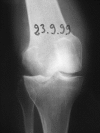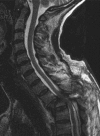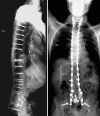Spinal neuroarthropathy associated with Guillain-Barré syndrome
- PMID: 19707801
- PMCID: PMC2899632
- DOI: 10.1007/s00586-009-1131-5
Spinal neuroarthropathy associated with Guillain-Barré syndrome
Abstract
Since the rarefaction of neurosyphilis, axial neuroarthropathy is mostly secondary to spinal cord pathologies. Peripheral manifestations of neuroarthropathy resulting from Guillain-Barré syndrome have already been reported but to our knowledge, this is the first case of a patient diagnosed with axial involvement. After the acute phase, a 47-year-old woman suffered of paraparesia with a partial loss of sensibility under the tenth thoracic vertebra. As a consequence, she developed first of all neuroarthropathy of both knees and few years later, a spinal involvement was discovered. Multiple surgeries of both knees and of the spine were required, due to non-union, relapse, and infection. Natural evolution of Charcot spine remains unknown. Surgical treatment is recommended but even with circumferential fusion, failures do frequently occur. This observation allows us to report an original case and to discuss the etiology of axial neuroarthropathy, the classical radiographic findings, and the inherent difficulties of its treatment.
Figures





Similar articles
-
Shortening osteotomy for the treatment of spinal neuroarthropathy following spinal cord injury. A case report and literature review.Eur Spine J. 2007 Dec;16 Suppl 3(Suppl 3):318-21. doi: 10.1007/s00586-007-0343-9. Epub 2007 Mar 22. Eur Spine J. 2007. PMID: 17377824 Free PMC article.
-
Surgical treatment of Charcot spine.J Spinal Disord Tech. 2007 Feb;20(1):85-8. doi: 10.1097/01.bsd.0000211245.29458.03. J Spinal Disord Tech. 2007. PMID: 17285059
-
Onset of a Charcot spinal arthropathy at a level lacking surgical arthrodesis in a paraplegic patient with traumatic cord injury.Eur Spine J. 2010 Jul;19 Suppl 2(Suppl 2):S83-6. doi: 10.1007/s00586-009-1055-0. Epub 2009 Jun 7. Eur Spine J. 2010. PMID: 19504271 Free PMC article.
-
Autonomic dysreflexia associated with Charcot spine following spinal cord injury: a case report and literature review.Eur Spine J. 2010 Jul;19 Suppl 2(Suppl 2):S179-82. doi: 10.1007/s00586-010-1296-y. Epub 2010 Feb 4. Eur Spine J. 2010. PMID: 20130931 Free PMC article. Review.
-
Spinal Neuroarthropathy: Pathophysiology, Clinical and Imaging Features, and Differential Diagnosis.Radiographics. 2016 May-Jun;36(3):783-99. doi: 10.1148/rg.2016150121. Epub 2016 Apr 8. Radiographics. 2016. PMID: 27058729 Review.
Cited by
-
Charcot spinal arthropathy.J Craniovertebr Junction Spine. 2018 Jan-Mar;9(1):9-19. doi: 10.4103/jcvjs.JCVJS_130_17. J Craniovertebr Junction Spine. 2018. PMID: 29755231 Free PMC article. Review.
-
Exceptional Spinal Mobility Caused by Charcot Disease: Case Description with Several Years of Follow-Up.Indian J Orthop. 2023 Jul 1;57(8):1338-1343. doi: 10.1007/s43465-023-00937-z. eCollection 2023 Aug. Indian J Orthop. 2023. PMID: 37525730 Free PMC article.
-
Successful surgical treatment of scoliosis secondary to Guillain-Barré syndrome: Case report.Medicine (Baltimore). 2016 Jun;95(26):e3775. doi: 10.1097/MD.0000000000003775. Medicine (Baltimore). 2016. PMID: 27367981 Free PMC article. Review.
-
A comprehensive review of the treatment and management of Charcot spine.Ther Adv Musculoskelet Dis. 2020 Dec 17;12:1759720X20979497. doi: 10.1177/1759720X20979497. eCollection 2020. Ther Adv Musculoskelet Dis. 2020. PMID: 33414850 Free PMC article. Review.
-
Rheumatoid arthritis-associated spinal neuroarthropathy with double-level isthmic spondylolisthesis.Eur Spine J. 2019 Sep;28(9):2145-2150. doi: 10.1007/s00586-017-5220-6. Epub 2017 Jul 28. Eur Spine J. 2019. PMID: 28755075
References
-
- ASIA (American Spinal Injury Association) (2008) Standard neurological classification of spinal cord injury. Available via http://www.asia-spinalinjury.org/publications/2006_Classif_worksheet.pdf. Accessed 1 June 2009
-
- Charcot JM (1868) Sur quelques arthropathies qui paraissent dépendre du cerveau ou de la moëlle épinière. Arch Phys Norm Pathol 1:161–178
-
- Cleveland M, Wilson HJ., Jr Charcot disease of the spine; a report of two cases treated by spine fusion. J Bone Joint Surg. 1959;41-A:336–340. - PubMed
Publication types
MeSH terms
LinkOut - more resources
Full Text Sources
Medical
Research Materials

